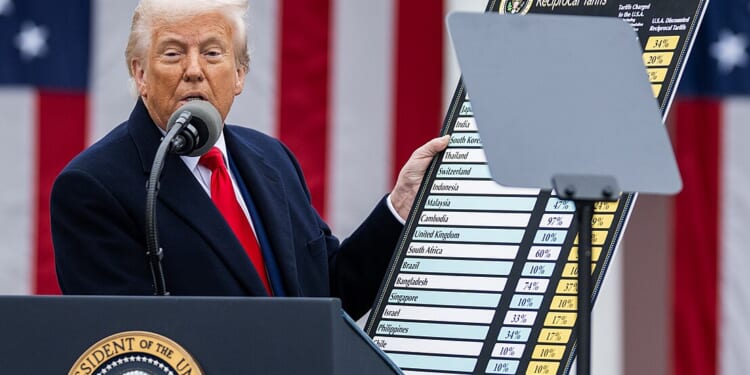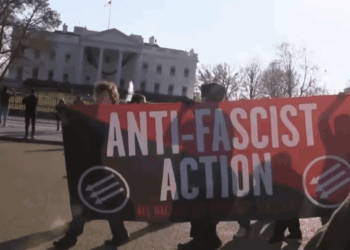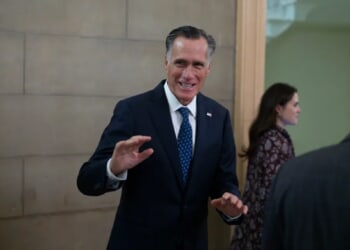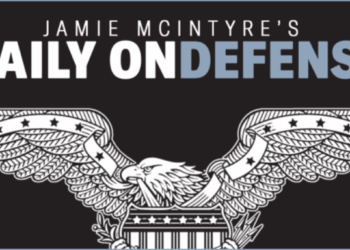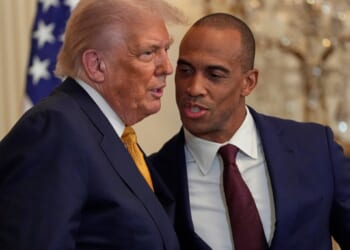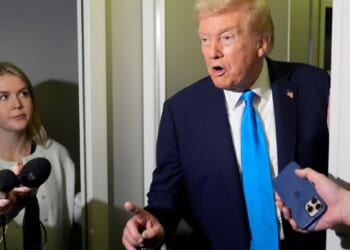Following an action-packed overseas trip to Asia last week, President Donald Trump is gearing up to tackle the next challenge facing his administration: a legal battle over his tariff policy.
On Wednesday, the U.S. Supreme Court will hold oral arguments in a pair of consolidated cases known as Learning Resources, Inc. v. Trump and Trump v. V.O.S. Selections, Inc. As The Federalist previously reported, these cases specifically center around the legality of Trump’s use of the International Emergency Economic Powers Act (IEEPA) to impose tariffs on goods from foreign nations making their way into the United States.
Enacted in 1977, IEEPA grants the president the power to “deal with any unusual and extraordinary threat, which has its source in whole or substantial part outside the United States, to the national security, foreign policy, or economy of the United States, if the President declares a national emergency with respect to such threat.” The Supreme Court will address the question of whether Trump’s invocation of tariffs under the statute’s existing provisions is lawful.
“It really feels like this is a coin flip in terms of the outcome,” Heritage Foundation Chief Economist E.J. Antoni told The Federalist. “Not only am I uncertain on how [the justices] are going to interpret the law, but I’m also uncertain on how they’re going to interpret the economic situation because there are competing economic theories here. … I think it could go either way.”
Background
The origins of these cases date back to earlier this year, when Trump invoked IEEPA to impose tariffs on a variety of countries. As described by the president, he did so in response to existing “unfair trade practices” that lead to trade deficits, as well as to punish countries like China for failing to “blunt the sustained influx of synthetic opioids, including fentanyl, flowing from the [People’s Republic of China] to the United States.”
Invoking IEEPA’s language, the president reasoned that these problems constitute an “unusual and extraordinary threat” to the United States.
It wasn’t long after the issuance of his April 2025 “Liberation Day” tariffs that Trump and his administration were the subjects of two separate lawsuits: one filed by Learning Resources, Inc. (and hand2mind, Inc.) and another by V.O.S. Selections, Inc.
The former’s legal challenge was brought in the U.S. District Court for the District of Columbia, which initially granted their request for a preliminary injunction but ultimately paused the block as proceedings in the case continued.
Meanwhile, V.O.S. Selections’ suit resulted in the U.S. Court of International Trade (CIT) issuing a permanent injunction that prevented a number of tariff-related executive orders from taking effect. Upon appeal, the U.S. Court of Appeals for the Federal Circuit — after hearing the case en banc — ultimately affirmed the CIT’s ruling that the tariffs are unlawful but terminated its injunction and remanded the case for further proceedings.
SCOTUS agreed to take up both cases (consolidated) in early September.
Key Arguments
In their respective filings with SCOTUS, Learning Resources and V.O.S. Selections argued that the president lacks the constitutional authority to impose tariffs under IEEPA. They specifically cited the first clause of Article I Section 8 of the Constitution, which states that, “Congress shall have Power To lay and collect Taxes, Duties, Imposts and Excises, to pay the Debts and provide for the common Defence and general Welfare of the United States; but all Duties, Imposts and Excises shall be uniform throughout the United States.”
“IEEPA does not give the President the vast power he has seized,” Learning Resources’ petition for certiorari reads. “IEEPA does not mention the word ‘tariff’ or ‘tax,’ and no other President in its nearly 50-year history has ever relied on it for tariffing power.”
In its Sept. 19 motion on the merits of the cases, the Trump administration argued the opposite — that “President Trump’s IEEPA tariffs are plainly lawful” and that “Congress has long granted the President broad authority to employ tariffs to address emergencies.” “IEEPA,” the Justice Department claimed, “continues that tradition by expressly authorizing the President to ‘regulate * * * importation’ of foreign goods to address declared national emergencies.”
“Presidents have relied on IEEPA to address a wide array of emergencies and ‘IEEPA embodies an eyes-open congressional grant of broad emergency authority in this foreign-affairs realm,’” the motion reads. “President Trump determined that tariffs are best suited to address the trade-deficit and drug-trafficking emergencies, and those determinations warrant deference. IEEPA provides that Congress and the political process, not the judiciary, serve as the principal monitor and check on the President’s exercise of IEEPA authority.”
The Road Ahead
While the Supreme Court (and other courts) has tackled matters involving tariffs throughout its history, it remains unclear how the justices will grapple with Trump’s use of IEEPA in these two cases, according to Antoni.
In expressing uncertainty about how the high court will come down on the issue, the Heritage fellow noted the differing consensus among economists about whether trade deficits “are always a problem.” He further questioned whether and how the justices will deal with such differences when handling these cases.
“Even among the economics field, you don’t have the kind of universal agreement that I would’ve, at one point, expected” about the trade-deficit argument the administration is making, Antoni said. “So, if you don’t have it there, it should be no surprise if you don’t have the same kind of agreement among laymen. And in this case, when it comes to the Supreme Court, they are economic laymen. This isn’t their area of expertise, and that’s not a knock on them.”
Antoni went on to add that, regardless of how SCOTUS comes down on the cases, the president and his administration have “so many other tools at their disposal” outside IEEPA to implement tariffs to tackle what they consider to be economic and national security issues.
“There are other ways that the president and his administration can put these tariffs into place, and so I would expect that that’s just basically gonna continue,” Antoni said. “It’s a more arduous process. It’s more difficult to get those things in place, but I have no reason to think that the administration is simply gonna say, ‘Well, they took one tool out of our tool kit and now we give up. We’re never gonna try this again.’”
Oral arguments in Learning Resources, Inc. v. Trump and Trump v. V.O.S. Solutions are expected to begin at 10 a.m. ET on Wednesday. A final decision on the matter is not expected until later in the Supreme Court’s 2025-2026 term.
Shawn Fleetwood is a staff writer for The Federalist and a graduate of the University of Mary Washington. He previously served as a state content writer for Convention of States Action and his work has been featured in numerous outlets, including RealClearPolitics, RealClearHealth, and Conservative Review. Follow him on Twitter @ShawnFleetwood

